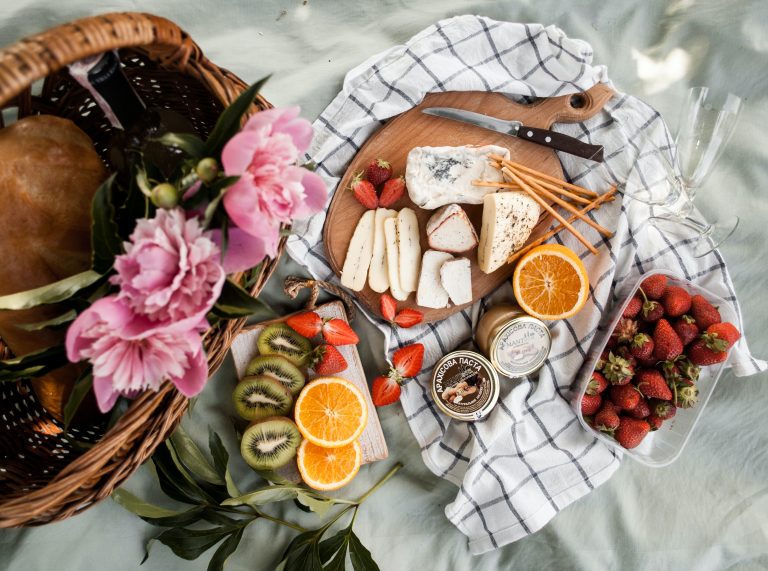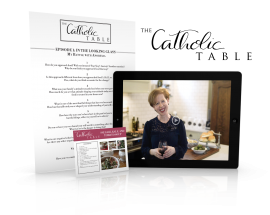By Emily Stimpson Chapman
Emily Stimpson Chapman is the award-winning author of several books and the host of the video study The Catholic Table.

Some people like movies about puppies. Or horses. Or cars. Me? I like movies about food. Which is why I went poste-haste to Pranzo Di Ferragosto (literally “Mid-August Lunch”) when it came to Pittsburgh a few years back.
A charming little movie about what makes a feast, the film tells the tale of Gianni, a middle-aged man stuck in Rome with his mother and three elderly women, while the rest of the city flees to the countryside to celebrate the Feast of the Assumption. Broke and unemployed, Gianni has two things going for him: limitless stores of patience and a near miraculous ability to cobble together mouth-watering meals from the simplest of ingredients on the most meager of budgets.
As the rest of the city celebrates elsewhere, Gianni puts those two skills to work, assembling a feast for his mother and her friends that, over the course of a leisurely day and even more leisurely night, turns their sticky Roman apartment into an oasis of joy.
And it really is Gianni—his generosity, his patience, his love— not the food, that transforms the apartment and the people within it. Gianni, for all his faults, sees the beauty in his ill and aged guests. He honors them with his cooking, but he honors them even more with his attention. And that—his vision and love—is what makes their poor, city celebration a far greater one than all the other, far more lavish celebrations taking place elsewhere.
Accordingly, when I left the film, I resolved to do two things.
First, I resolved to celebrate the Assumption henceforth like the Italians do—not using my day off work to catch up on work, but rather as a day of leisure, the type of leisure that points forward to the life of feasting and fellowship we all hope to enjoy in Heaven.
Second, I resolved to model my own hosting more after Gianni’s hosting—to combat my inner-Martha and make my guests, not the work involved with hosting them, my priority.
The first resolution I mastered with ease.
Ever since that day three years ago, when I first saw Pranzo di Ferragosto, my friends and I have celebrated our own mid-August lunch. After morning Mass, we spend the day cooking, feasting, and talking about nothing and everything. We let the children run wild on the lawn, and we sit on the deck, keeping as close an eye on our supplies of wine as we do on them.
As for the second resolution, well, that’s taking a bit more time. Finding the balance between getting the food on the table and taking the time to engage each and every guest like they’re the only person in the room is a perpetual struggle. But it’s a struggle that brings with it great blessings.
It is, of course, a good thing to want to serve guests the very best and serve that in a space beautiful and neat. But, as Pranzo di Ferragosto helped me see with greater clarity, none of that matters to my guests as much as I do. My attention, my interest, my ready joy at their presence is what matters most. That’s what honors them the most. That, even more than food and wine, tells them they are welcomed and wanted. That tells them they are interesting and important. That gives them the foretaste of heavenly fellowship to which the Feast of the Assumption points.
Which, as the movie that bears the Feast’s name recognizes, is what a true pranzo di ferragosto is all about. It heeds the call to rejoice that one of our lowly race has already entered, body and soul, into the fullness of joy for which we all hope. And it heeds the call to imitate, in our own small way, the perpetual communion of the angels and saints. The food is a part of that. But the fellowship, the seeing and acknowledging the beauty of the other, is the greater part.
That seeing and acknowledging may mean dishes will go undone. Or that plans for a grander menu or more elaborate decorations must be set aside. Or even that the upstairs bathroom won’t be as clean as one would like.
But those things aren’t the essence of a proper pranzo di ferragosto. The essence is the people. And if the hostess remembers that, as Gianni did, the effect will be the same: The guests will walk away at the end of the night, thinking the party from whence they came was Heaven on earth.
You Might Also Like

It’s unavoidable. We all must eat. But as Catholics, we know that how we eat matters as much as what we eat. In her book The Catholic Table, award-winning author Emily Stimpson Chapman explains how food is a sign of God’s love and a foretaste of the Eucharist.
Now, in The Catholic Table video series, you’ll discover what the Church teaches about creation, the body, feasting, fasting, the Eucharist—and so much more.

The Bible and the Virgin Mary, part of the St. Paul Center’s Journey Through Scripture series, unveils the mystery of Our Lady that is woven into the fabric of Sacred Scripture. Twelve visually stunning lessons convey the beauty of the doctrine and devotions surrounding Mary, bringing them to life in a powerful, new way.